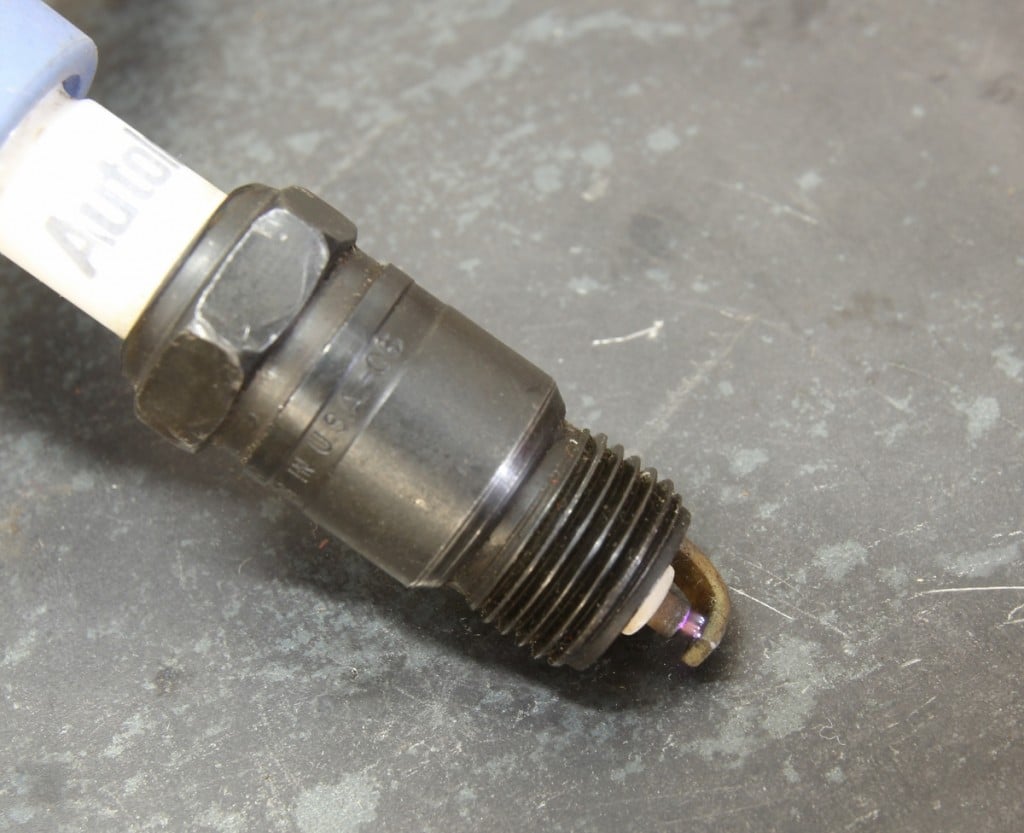
Spark intensity isn’t something a lot of people pay attention to — but they should. Feeding the coil with 14 volts instead of 7 automatically improves spark intensity, improving throttle response, fuel mileage, and maybe even adding a bit more power, too.
Words and Photos by Jeff Smith
Schematic by Eric Rosendahl
Performance car guys are all about making good cars better. The average person thinks anything from the factory is automatically the best it can be, but real car people know new technology usually means improvement.
A case study can be made with Ford and Mopar electronic ignition boxes from the ’70s. Honest Ford guys will admit that the Duraspark system has not lived up to its name, and replacement boxes are even less reliable. While original factory Mopar ignition boxes are good, the design for both the Ford and Mopar boxes suffers from an often overlooked, yet crucial design consideration.
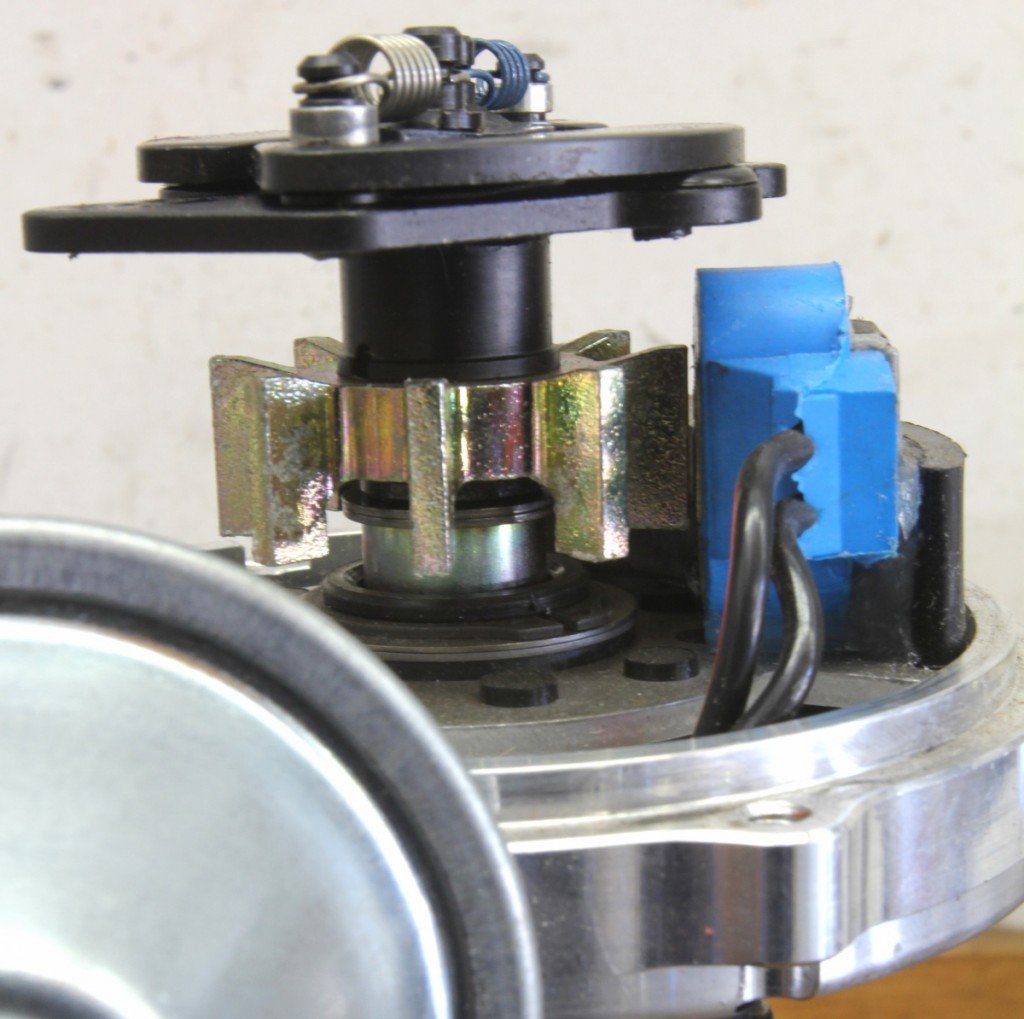
A magnetic pickup creates a signal when the rotating pole piece on the distributor shaft crosses the fixed magnet. This generates a tiny signal that triggers the coil — essentially an electronic version of a set of mechanical points, except no voltage passes through the pickup like it does with ignition points.
The typical response on many forums to questions about these factory ignitions is the simplistic: “Just stick an MSD on it!” While that’s one solution, this skips over a fundamental approach to hot rodding — using good factory parts for a performance application.
Before we get into the details of how easy it is to adapt an HEI module to a Ford or Mopar magnetic distributor, we have to put this whole brand loyalty thing on the table. We can already hear the Mopar guys screaming, “Install a GM part on my Mopar — over my dead body!” For those who share that sentiment, save the trouble of addressing those poison emails to this author; this story is clearly not for you. But for the rest of the performance world who is open-minded enough to learn something new and to whom performance efficiency is more important than blind brand loyalty, please follow along.
First, let’s address the weakness in the Ford and Mopar ignition systems. If we look closely at a wiring schematic of either system, both include either a resistor wire (Ford) or a ballast resistor (Mopar) that limits the voltage to the positive side of the coil. This is done to limit the amount of voltage fed to the coil to prevent it from overheating at low engine speeds.
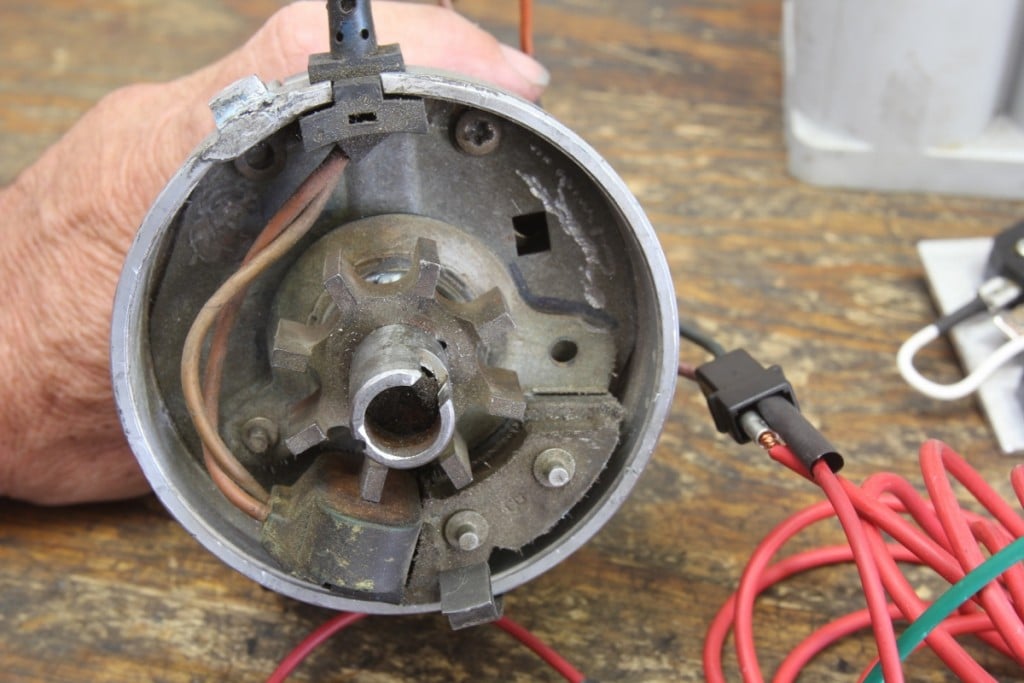
This is a Ford DuraSpark distributor our buddy, Tim Moore, pulled out of the junkyard. He eliminated the vacuum advance can and filled in the hole to make it appear more like a mid-’60s Ford dual point distributor. He has converted the wiring to a two-pin connector as used on an MSD distributor. We can now use this distributor to trigger an HEI module.
The main reason for the resistor is because the original coils used with these ignitions were the oil-filled canister design with high internal resistance. The resistor circuit can often be the cause of a loss of ignition performance if, after decades of use, the resistance in the circuit increases, even further reducing the voltage fed to the coil. Bone stock, these systems delivered around 6 to7 volts to the positive side of the coil. Less voltage in means less power delivered to the spark plugs.
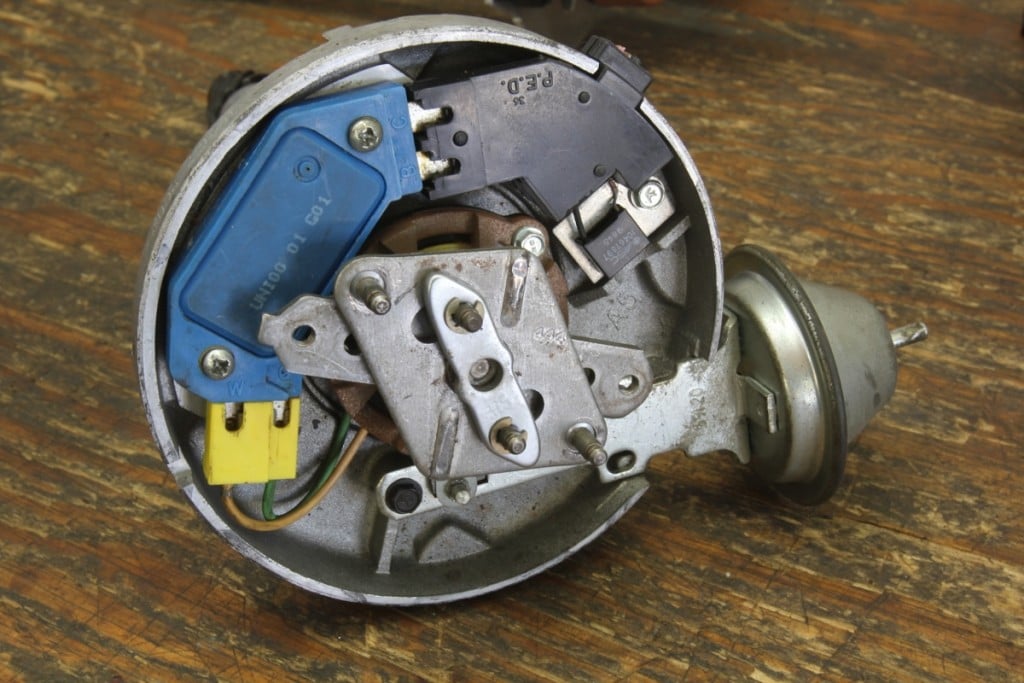
This is an HEI large cap distributor, and you can clearly see the blue four-pin module bolted in place. This module can be easily adapted to any magnetic pickup distributor, like either a Ford or Mopar version.
When GM designed the high energy ignition (HEI), engineers combined the electronic module with a completely new design coil called an E-core or laminated core coil. The E-core cools the windings more efficiently because the coils are exposed to the air. This allows the coil designer to reduce the coil’s internal resistance. Old-school oil-filled coils typically measure 1.0 to 1.5 ohms of primary circuit resistance. E-core coils operate with as little at 0.30 ohms. With less resistance, the coils can accept a higher feed voltage and generate more secondary spark energy and higher spark plug gap voltage, creating a more powerful ignition system.
The HEI module is designed to supply the E-core coil with the full-system voltage of generally 14.0 to 14.5 volts. The Ford or Mopar electronic boxes are limited with either a resistor wire or large ballast resistor that limits the voltage to the primary side of the coil to around 7.0 to 7.5 volts. It should be obvious which system will perform more efficiently.
Now that we have some actual facts to support this concept, it might become clear why the HEI module would be the equivalent of bolting in a high-performance ignition system on even a stock Mopar Slant 6. This is not new technology; several ignition companies offer HEI-style distributors for Ford and Mopar engine applications. While there’s nothing wrong with this approach, the conversion requires replacing the original distributor. But if you have a Ford or Mopar magnetic pickup distributor, you already have the correct distributor for a conversion.
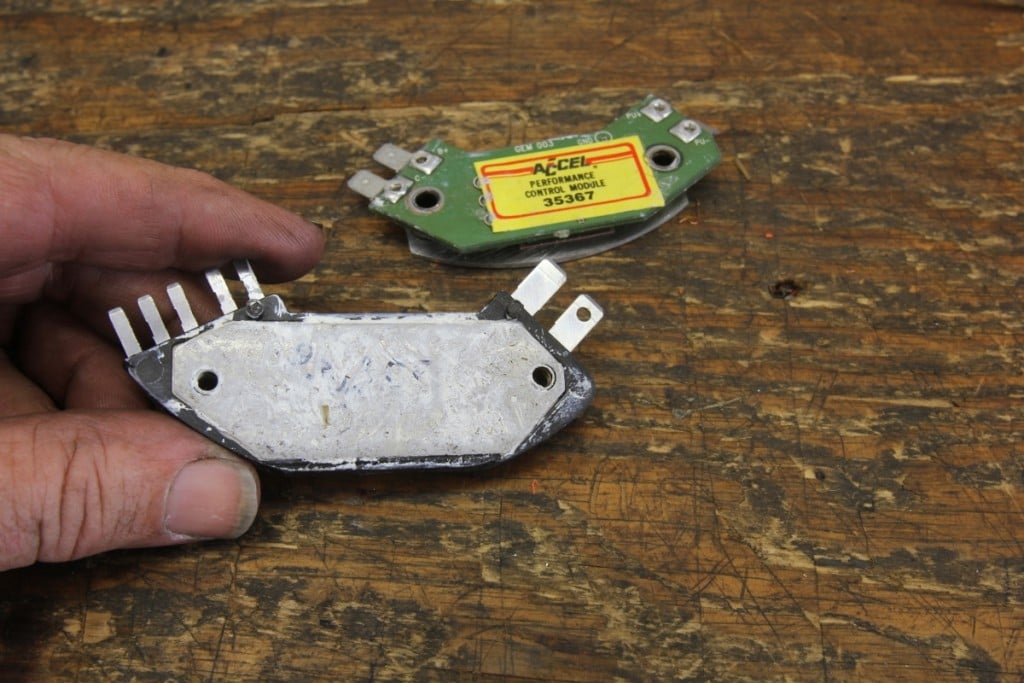
Here are two performance HEI modules. Note we’ve spread a white thermal transfer paste on the backside of this module. This will aid in managing the heat created by the module. Do not use MSD Spark Guard. That material is actually an insulator, which will contribute to overheating and failing the module, so don’t make that mistake. We’ve listed a couple of sources for thermal transfer paste in the Parts List.
But first, we need to know a little bit more about magnetic pickups. The process is pretty simple. The distributor shaft is equipped with eight (for a V-8 application) pole pieces or lugs that rotate with the shaft. The pickup contains a magnet that creates a tiny signal every time a lug passes across the pickup. This system essentially replaces the old points system with a more reliable switching mechanism. Every time the pole piece triggers the magnetic pickup, it sends a signal to fire the coil then eventually finds its way to the spark plug.
So, now that you have a grasp on the technology, let’s look at how to adapt it to a typical electronic-style distributor. The early Ford DuraSpark I and II and Mopar electronic distributors employ a magnetic pickup much like the GM HEI. The only critical information you need is to determine which wire on the magnetic pickup is the trigger wire and which is the ground.
For the early Ford two-wire distributors, the orange wire is the signal wire (+) that connects to the “W” terminal on the HEI module, while the brown wire is ground (-) that connects to the HEI “G” terminal. Later, DuraSpark versions came with three wires, with the third black wire as an additional ground. In this three-wire version, orange is the signal wire (+), while the violet or purple is ground (-). Mopar distributors use a black wire for the ground side (-), while the orange wire is the signal (+) connection. It’s that simple.
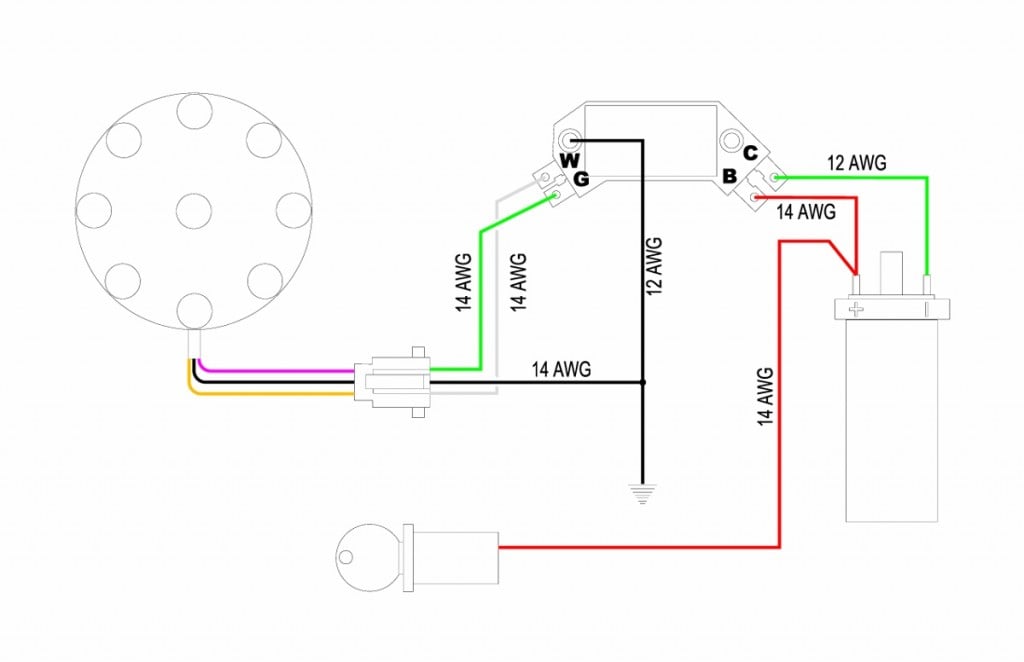
This schematic shows the connections necessary to wire up the HEI module to any magnetic pickup distributor. Note the distributor we’re using has three wires exiting the distributor. The third black wire is a ground. While the wire colors from the magnetic pickup will be different, they all wire up the same way.
We’ve created a schematic that reveals just how simple the wiring is for an HEI module. In this illustration, we show a third wire exiting the distributor, like the later Ford versions. The colors coming from the distributor will also change based on the original manufacturer, but otherwise, the information doesn’t change. The “W” terminal on the left side of the HEI module is the signal connection, while the “G” terminal is the ground.
On the power side of the module, the “B” terminal always connects to the switched power or battery (+) of the coil, while the “C” terminal goes to the negative (-) side of the coil. With those four simple connections, plus adding a ground between the module, mounting base, and the engine and battery, will produce a functioning ignition system.
We mounted our HEI module on a 1/8-inch thick aluminum plate and added a wiring terminal strip just for grins, but this could be easily eliminated. We also found a cool, affordable aluminum bracket offered by Deisgned2drive.com that mounts the HEI module underneath the Mopar distributor.
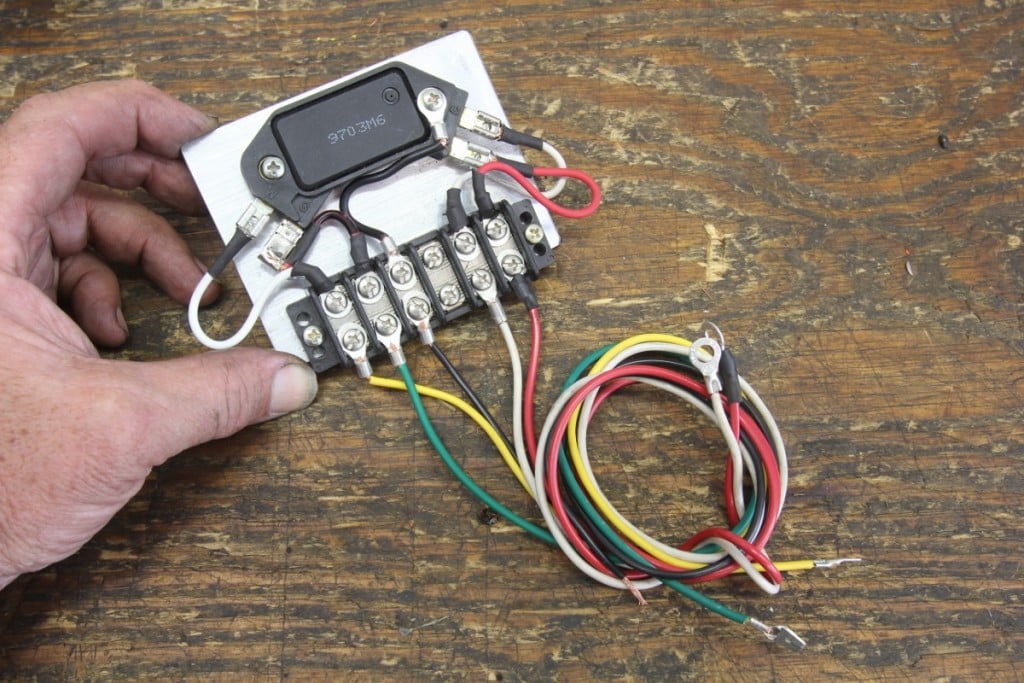
We mounted an HEI module to an aluminum plate and also added a wiring terminal strip, but that could easily be eliminated, as it isn’t necessary.
To add a little more fun to this idea, consider that the magnetic pickup used in these Ford and Mopar distributors is the same style pickup employed in MSD distributors. So, this makes it really easy to convert an existing Ford or Mopar distributor to use a FAST, MSD, Pertronix, or any other company’s capacitive discharge (CD) style ignition system. In fact, MSD makes a slick wiring adapter to convert your distributor to the small, two-pin MSD connector. Then, even with a CD ignition in the car, you can also keep that small aluminum HEI module plate as a backup. That way if the MSD box fails, it would only require a few simple wiring connections to hook up the HEI module.
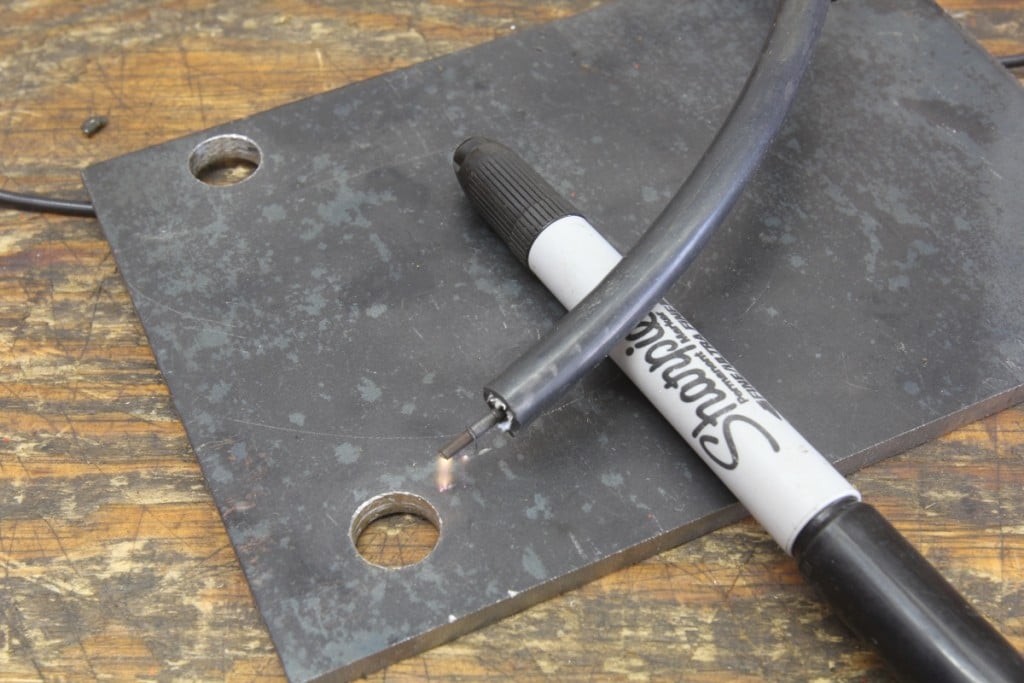
We rigged a simple bench test to show how this idea works with a Ford distributor. We wired the HEI module and coil according to the schematic, grounded the steel plate, the HEI mounting plate, and the distributor all to a 12-volt battery, and spun the distributor to create a hot spark right off the coil wire.
Hopefully, we’ve given you some ideas on how to upgrade a Ford or Mopar ignition to something a little more powerful at an extremely low cost. Sometimes, good ideas can also turn out to be the least expensive.
Parts List
| Description | PN | Source | Price |
| Accel 4-pin HEI module | 35361 | Summit Racing | $45.14 |
| Performance Dist. 4-pin module | 000222 | Summit Racing | $55.00 |
| Mallory 4-pin HEI module | 699 | Summit Racing | $109.50 |
| Proform 4-pin HEI module | 669446 | Summit Racing | $22.97 |
| Pertronix race module, rev limiter | D72000 | Summit Racing | $73.97 |
| Pertronix 4-pin street module | D2000 | Summit Racing | $45.97 |
| Summit 4-pin HEI module | 850100 | Summit Racing | $39.97 |
| Standard Motor 4-pin module | KS301 | RockAuto | $32.97 |
| Delphi 4-pin module | DS10071 | RockAuto | $18.58 |
| Mopar dist. mount bracket | ——— | Designed2drive.com | $21.50 |
| MSD pigtail | 8861 | Summit Racing | $8.27 |
| Thermal conductive paste, 1oz. | 107-0001 | WalMart | $3.96 |
| Thermal conductive paste | SL203 | Auto Zone | $2.49 |
Sources: Designed2drive.com; Holley Performance Products, (Accel), holley.com; Performance Distributors, performancedistributors.com; Pertronix, pertronix.com; RockAuto; rockauto.com

















